Accounting and Finance: WAACC and Capital Structure of AMP Ltd
VerifiedAdded on 2023/06/04
|15
|3256
|305
Report
AI Summary
This report provides a comprehensive analysis of accounting and finance principles, focusing on capital structure and risk assessment. It begins with an evaluation of a proposed capital investment, calculating after-tax cash flows, payback period, net present value, and profitability index. Sensitivity analysis is conducted by considering scenarios with 5% higher and 5% lower estimated values. The report then shifts to an analysis of AMP Limited's weighted average cost of capital (WAACC) and capital structure, comparing it with Canaccord Genuity Group Inc. Significant changes in AMP Limited's capital structure over the past three years are examined, followed by a risk analysis based on annual reports and financial statements. The report concludes with a recommendation regarding the proposed capital investment and an assessment of AMP Limited's financial strategies.

Accounting and finance
Paraphrase This Document
Need a fresh take? Get an instant paraphrase of this document with our AI Paraphraser
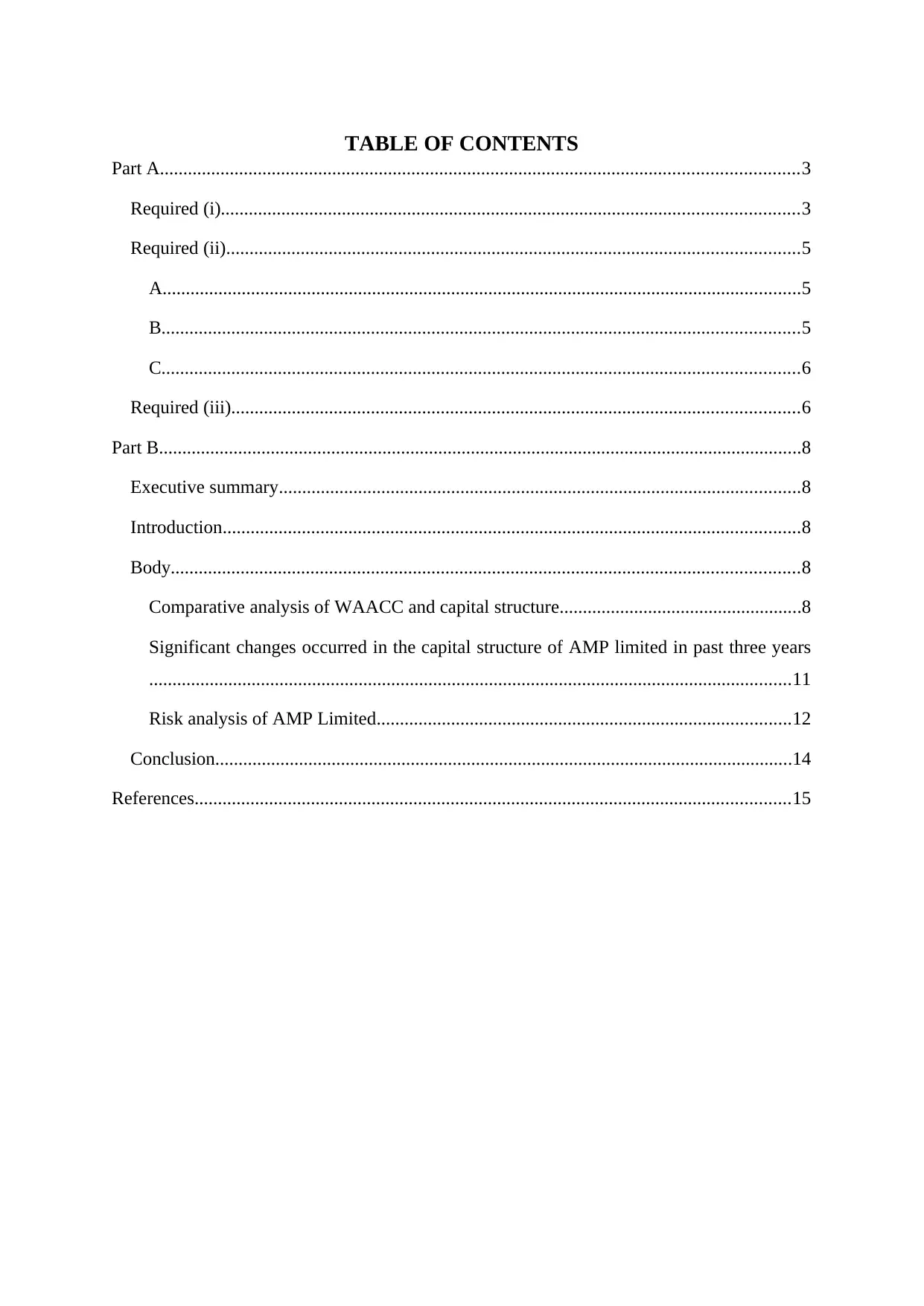
TABLE OF CONTENTS
Part A.........................................................................................................................................3
Required (i)............................................................................................................................3
Required (ii)...........................................................................................................................5
A.........................................................................................................................................5
B.........................................................................................................................................5
C.........................................................................................................................................6
Required (iii)..........................................................................................................................6
Part B..........................................................................................................................................8
Executive summary................................................................................................................8
Introduction............................................................................................................................8
Body.......................................................................................................................................8
Comparative analysis of WAACC and capital structure....................................................8
Significant changes occurred in the capital structure of AMP limited in past three years
..........................................................................................................................................11
Risk analysis of AMP Limited.........................................................................................12
Conclusion............................................................................................................................14
References................................................................................................................................15
Part A.........................................................................................................................................3
Required (i)............................................................................................................................3
Required (ii)...........................................................................................................................5
A.........................................................................................................................................5
B.........................................................................................................................................5
C.........................................................................................................................................6
Required (iii)..........................................................................................................................6
Part B..........................................................................................................................................8
Executive summary................................................................................................................8
Introduction............................................................................................................................8
Body.......................................................................................................................................8
Comparative analysis of WAACC and capital structure....................................................8
Significant changes occurred in the capital structure of AMP limited in past three years
..........................................................................................................................................11
Risk analysis of AMP Limited.........................................................................................12
Conclusion............................................................................................................................14
References................................................................................................................................15

PART A
Required (i)
After-tax cash flows
(A) Statement Showing After-tax Cash Flows for the proposed "Buddy" Capital Investment
(IN Million AUD $)
Particulars Year
1
Year
2
Year
3
Year
4
Year
5
Year
6
Year
7
Year
8
Year
9
Year
10
Unit Sales 16.0
0
16.0
0
16.0
0
16.0
0
16.0
0
16.0
0
16.0
0
16.0
0 16.00 16.00
Sales Price per Unit 1.25 1.28 1.31 1.34 1.37 1.40 1.44 1.47 1.51 1.54
Total Sales Revenue 20.0
0
20.4
7
20.9
5
21.4
4
21.9
5
22.4
6
22.9
9
23.5
3 24.08 24.65
Cost of Raw
Material 7.00 7.00 7.00 7.00 7.00 7.00 7.00 7.00 7.00 7.00
Fixed Conversion
Cost 5.60 5.60 5.60 5.60 5.60 5.60 5.60 5.60 5.60 5.60
Variable
Conversion Cost 1.40 1.40 1.40 1.40 1.40 1.40 1.40 1.40 1.40 1.40
Gross Profit 6.00 6.47 6.95 7.44 7.95 8.46 8.99 9.53 10.08 10.65
Depreciation 1.95 1.95 1.95 1.95 1.95 1.95 1.95 1.95 1.95 1.95
Profit Before Tax 4.05 4.52 5.00 5.49 6.00 6.51 7.04 7.58 8.13 8.70
Tax @ 30% 1.22 1.36 1.50 1.65 1.80 1.95 2.11 2.27 2.44 2.61
Profit After Tax 2.84 3.16 3.50 3.85 4.20 4.56 4.93 5.31 5.69 6.09
Depreciation 1.95 1.95 1.95 1.95 1.95 1.95 1.95 1.95 1.95 1.95
Salvage Value 0.00 0.00 0.00 0.00 0.00 0.00 0.00 0.00 0.00 5.00
Cash Flows after
Tax 4.79 5.11 5.45 5.80 6.15 6.51 6.88 7.26 7.64 13.04
Payback period
Computation of Payback Period
Years Cash Flows (IN Million $) Cumulative Cash Flow
0 -20 0
1 4.79 4.79
2 5.11 9.90
3 5.45 15.35
4 5.80 21.15
5 6.15 27.30
6 6.51 33.81
7 6.88 40.69
8 7.26 47.94
Required (i)
After-tax cash flows
(A) Statement Showing After-tax Cash Flows for the proposed "Buddy" Capital Investment
(IN Million AUD $)
Particulars Year
1
Year
2
Year
3
Year
4
Year
5
Year
6
Year
7
Year
8
Year
9
Year
10
Unit Sales 16.0
0
16.0
0
16.0
0
16.0
0
16.0
0
16.0
0
16.0
0
16.0
0 16.00 16.00
Sales Price per Unit 1.25 1.28 1.31 1.34 1.37 1.40 1.44 1.47 1.51 1.54
Total Sales Revenue 20.0
0
20.4
7
20.9
5
21.4
4
21.9
5
22.4
6
22.9
9
23.5
3 24.08 24.65
Cost of Raw
Material 7.00 7.00 7.00 7.00 7.00 7.00 7.00 7.00 7.00 7.00
Fixed Conversion
Cost 5.60 5.60 5.60 5.60 5.60 5.60 5.60 5.60 5.60 5.60
Variable
Conversion Cost 1.40 1.40 1.40 1.40 1.40 1.40 1.40 1.40 1.40 1.40
Gross Profit 6.00 6.47 6.95 7.44 7.95 8.46 8.99 9.53 10.08 10.65
Depreciation 1.95 1.95 1.95 1.95 1.95 1.95 1.95 1.95 1.95 1.95
Profit Before Tax 4.05 4.52 5.00 5.49 6.00 6.51 7.04 7.58 8.13 8.70
Tax @ 30% 1.22 1.36 1.50 1.65 1.80 1.95 2.11 2.27 2.44 2.61
Profit After Tax 2.84 3.16 3.50 3.85 4.20 4.56 4.93 5.31 5.69 6.09
Depreciation 1.95 1.95 1.95 1.95 1.95 1.95 1.95 1.95 1.95 1.95
Salvage Value 0.00 0.00 0.00 0.00 0.00 0.00 0.00 0.00 0.00 5.00
Cash Flows after
Tax 4.79 5.11 5.45 5.80 6.15 6.51 6.88 7.26 7.64 13.04
Payback period
Computation of Payback Period
Years Cash Flows (IN Million $) Cumulative Cash Flow
0 -20 0
1 4.79 4.79
2 5.11 9.90
3 5.45 15.35
4 5.80 21.15
5 6.15 27.30
6 6.51 33.81
7 6.88 40.69
8 7.26 47.94
⊘ This is a preview!⊘
Do you want full access?
Subscribe today to unlock all pages.

Trusted by 1+ million students worldwide

9 7.64 55.59
10 13.04 68.63
Payback Period = 3 + (21.15 - 20) / 5.80
3.19 Years
Net present value
(C) Statement Showing Net Present Value for the proposed "Buddy" Capital
Investment (IN Million AUD $)
Particulars Year 1 Year
2
Year
3
Year
4
Year
5
Year
6
Year
7
Year
8
Year
9
Year
10
Unit Sales 16.00 16.00 16.00 16.00 16.00 16.00 16.00 16.00 16.00 16.00
Sales Price per Unit 1.25 1.28 1.31 1.34 1.37 1.40 1.44 1.47 1.51 1.54
Total Sales Revenue 20.00 20.47 20.95 21.44 21.95 22.46 22.99 23.53 24.08 24.65
Cost of Raw Material 7.00 7.00 7.00 7.00 7.00 7.00 7.00 7.00 7.00 7.00
Fixed Conversion
Cost 5.60 5.60 5.60 5.60 5.60 5.60 5.60 5.60 5.60 5.60
Variable Conversion
Cost 1.40 1.40 1.40 1.40 1.40 1.40 1.40 1.40 1.40 1.40
Gross Profit 6.00 6.47 6.95 7.44 7.95 8.46 8.99 9.53 10.08 10.65
Depreciation 1.95 1.95 1.95 1.95 1.95 1.95 1.95 1.95 1.95 1.95
Profit Before Tax 4.05 4.52 5.00 5.49 6.00 6.51 7.04 7.58 8.13 8.70
Tax @ 30% 1.22 1.36 1.50 1.65 1.80 1.95 2.11 2.27 2.44 2.61
Profit After Tax 2.84 3.16 3.50 3.85 4.20 4.56 4.93 5.31 5.69 6.09
Depreciation 1.95 1.95 1.95 1.95 1.95 1.95 1.95 1.95 1.95 1.95
Salvage Value 0.00 0.00 0.00 0.00 0.00 0.00 0.00 0.00 0.00 5.00
Cash Flows after Tax 4.79 5.11 5.45 5.80 6.15 6.51 6.88 7.26 7.64 13.04
Present Value Factor
@ 20% 0.833 0.694 0.579 0.482 0.402 0.335 0.279 0.233 0.194 0.162
Present Value of Cash
Flows 3.988 3.551 3.154 2.795 2.471 2.180 1.920 1.688 1.481 2.106
Total Present Value of
Cash Flows 25.33
Initial Capital Outlay 20.00
Net Present Value 5.334
Profitability index
Present Value of Cash Inflows / Present Value of Cash Outflows
25.33/20
10 13.04 68.63
Payback Period = 3 + (21.15 - 20) / 5.80
3.19 Years
Net present value
(C) Statement Showing Net Present Value for the proposed "Buddy" Capital
Investment (IN Million AUD $)
Particulars Year 1 Year
2
Year
3
Year
4
Year
5
Year
6
Year
7
Year
8
Year
9
Year
10
Unit Sales 16.00 16.00 16.00 16.00 16.00 16.00 16.00 16.00 16.00 16.00
Sales Price per Unit 1.25 1.28 1.31 1.34 1.37 1.40 1.44 1.47 1.51 1.54
Total Sales Revenue 20.00 20.47 20.95 21.44 21.95 22.46 22.99 23.53 24.08 24.65
Cost of Raw Material 7.00 7.00 7.00 7.00 7.00 7.00 7.00 7.00 7.00 7.00
Fixed Conversion
Cost 5.60 5.60 5.60 5.60 5.60 5.60 5.60 5.60 5.60 5.60
Variable Conversion
Cost 1.40 1.40 1.40 1.40 1.40 1.40 1.40 1.40 1.40 1.40
Gross Profit 6.00 6.47 6.95 7.44 7.95 8.46 8.99 9.53 10.08 10.65
Depreciation 1.95 1.95 1.95 1.95 1.95 1.95 1.95 1.95 1.95 1.95
Profit Before Tax 4.05 4.52 5.00 5.49 6.00 6.51 7.04 7.58 8.13 8.70
Tax @ 30% 1.22 1.36 1.50 1.65 1.80 1.95 2.11 2.27 2.44 2.61
Profit After Tax 2.84 3.16 3.50 3.85 4.20 4.56 4.93 5.31 5.69 6.09
Depreciation 1.95 1.95 1.95 1.95 1.95 1.95 1.95 1.95 1.95 1.95
Salvage Value 0.00 0.00 0.00 0.00 0.00 0.00 0.00 0.00 0.00 5.00
Cash Flows after Tax 4.79 5.11 5.45 5.80 6.15 6.51 6.88 7.26 7.64 13.04
Present Value Factor
@ 20% 0.833 0.694 0.579 0.482 0.402 0.335 0.279 0.233 0.194 0.162
Present Value of Cash
Flows 3.988 3.551 3.154 2.795 2.471 2.180 1.920 1.688 1.481 2.106
Total Present Value of
Cash Flows 25.33
Initial Capital Outlay 20.00
Net Present Value 5.334
Profitability index
Present Value of Cash Inflows / Present Value of Cash Outflows
25.33/20
Paraphrase This Document
Need a fresh take? Get an instant paraphrase of this document with our AI Paraphraser
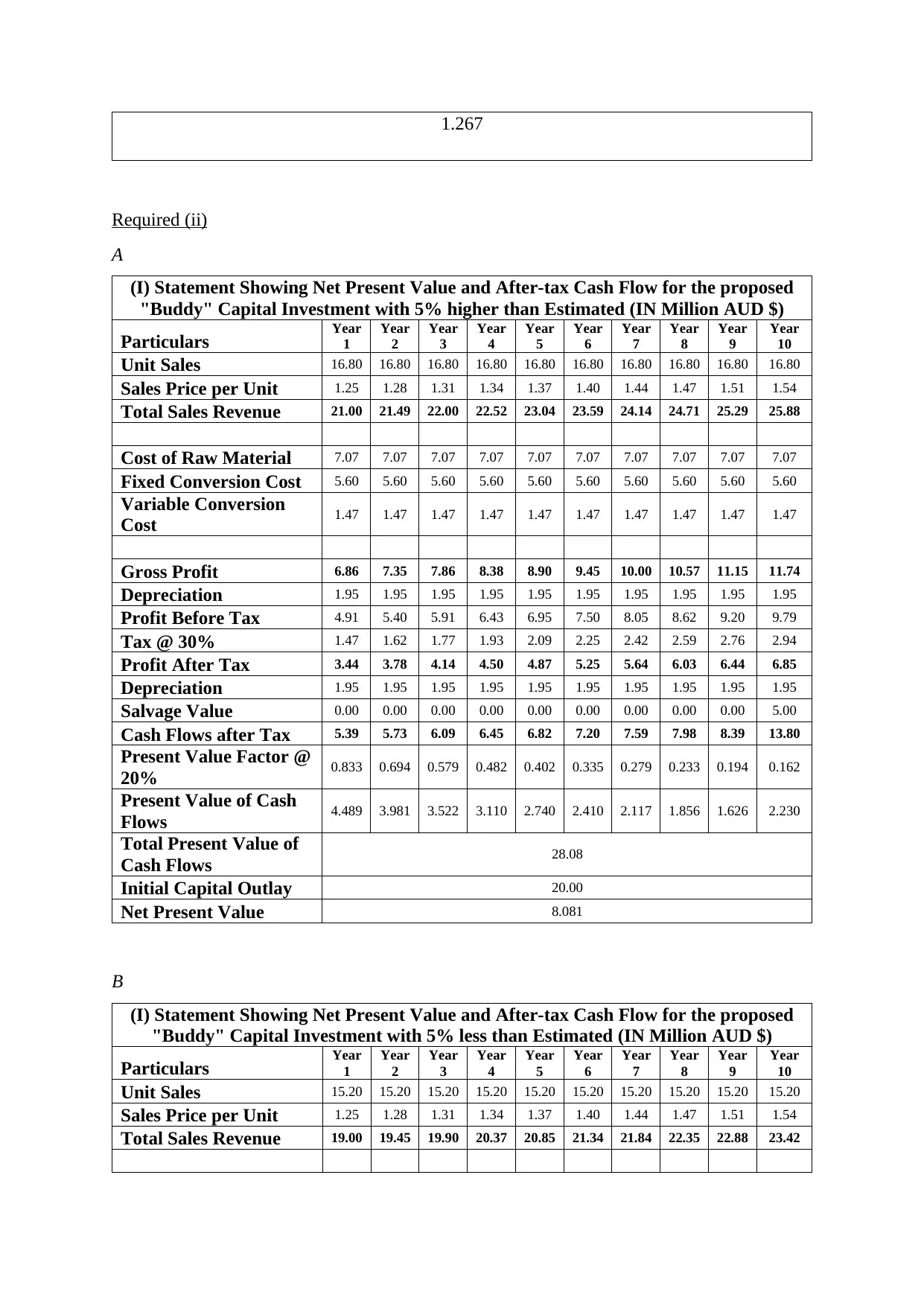
1.267
Required (ii)
A
(I) Statement Showing Net Present Value and After-tax Cash Flow for the proposed
"Buddy" Capital Investment with 5% higher than Estimated (IN Million AUD $)
Particulars Year
1
Year
2
Year
3
Year
4
Year
5
Year
6
Year
7
Year
8
Year
9
Year
10
Unit Sales 16.80 16.80 16.80 16.80 16.80 16.80 16.80 16.80 16.80 16.80
Sales Price per Unit 1.25 1.28 1.31 1.34 1.37 1.40 1.44 1.47 1.51 1.54
Total Sales Revenue 21.00 21.49 22.00 22.52 23.04 23.59 24.14 24.71 25.29 25.88
Cost of Raw Material 7.07 7.07 7.07 7.07 7.07 7.07 7.07 7.07 7.07 7.07
Fixed Conversion Cost 5.60 5.60 5.60 5.60 5.60 5.60 5.60 5.60 5.60 5.60
Variable Conversion
Cost 1.47 1.47 1.47 1.47 1.47 1.47 1.47 1.47 1.47 1.47
Gross Profit 6.86 7.35 7.86 8.38 8.90 9.45 10.00 10.57 11.15 11.74
Depreciation 1.95 1.95 1.95 1.95 1.95 1.95 1.95 1.95 1.95 1.95
Profit Before Tax 4.91 5.40 5.91 6.43 6.95 7.50 8.05 8.62 9.20 9.79
Tax @ 30% 1.47 1.62 1.77 1.93 2.09 2.25 2.42 2.59 2.76 2.94
Profit After Tax 3.44 3.78 4.14 4.50 4.87 5.25 5.64 6.03 6.44 6.85
Depreciation 1.95 1.95 1.95 1.95 1.95 1.95 1.95 1.95 1.95 1.95
Salvage Value 0.00 0.00 0.00 0.00 0.00 0.00 0.00 0.00 0.00 5.00
Cash Flows after Tax 5.39 5.73 6.09 6.45 6.82 7.20 7.59 7.98 8.39 13.80
Present Value Factor @
20% 0.833 0.694 0.579 0.482 0.402 0.335 0.279 0.233 0.194 0.162
Present Value of Cash
Flows 4.489 3.981 3.522 3.110 2.740 2.410 2.117 1.856 1.626 2.230
Total Present Value of
Cash Flows 28.08
Initial Capital Outlay 20.00
Net Present Value 8.081
B
(I) Statement Showing Net Present Value and After-tax Cash Flow for the proposed
"Buddy" Capital Investment with 5% less than Estimated (IN Million AUD $)
Particulars Year
1
Year
2
Year
3
Year
4
Year
5
Year
6
Year
7
Year
8
Year
9
Year
10
Unit Sales 15.20 15.20 15.20 15.20 15.20 15.20 15.20 15.20 15.20 15.20
Sales Price per Unit 1.25 1.28 1.31 1.34 1.37 1.40 1.44 1.47 1.51 1.54
Total Sales Revenue 19.00 19.45 19.90 20.37 20.85 21.34 21.84 22.35 22.88 23.42
Required (ii)
A
(I) Statement Showing Net Present Value and After-tax Cash Flow for the proposed
"Buddy" Capital Investment with 5% higher than Estimated (IN Million AUD $)
Particulars Year
1
Year
2
Year
3
Year
4
Year
5
Year
6
Year
7
Year
8
Year
9
Year
10
Unit Sales 16.80 16.80 16.80 16.80 16.80 16.80 16.80 16.80 16.80 16.80
Sales Price per Unit 1.25 1.28 1.31 1.34 1.37 1.40 1.44 1.47 1.51 1.54
Total Sales Revenue 21.00 21.49 22.00 22.52 23.04 23.59 24.14 24.71 25.29 25.88
Cost of Raw Material 7.07 7.07 7.07 7.07 7.07 7.07 7.07 7.07 7.07 7.07
Fixed Conversion Cost 5.60 5.60 5.60 5.60 5.60 5.60 5.60 5.60 5.60 5.60
Variable Conversion
Cost 1.47 1.47 1.47 1.47 1.47 1.47 1.47 1.47 1.47 1.47
Gross Profit 6.86 7.35 7.86 8.38 8.90 9.45 10.00 10.57 11.15 11.74
Depreciation 1.95 1.95 1.95 1.95 1.95 1.95 1.95 1.95 1.95 1.95
Profit Before Tax 4.91 5.40 5.91 6.43 6.95 7.50 8.05 8.62 9.20 9.79
Tax @ 30% 1.47 1.62 1.77 1.93 2.09 2.25 2.42 2.59 2.76 2.94
Profit After Tax 3.44 3.78 4.14 4.50 4.87 5.25 5.64 6.03 6.44 6.85
Depreciation 1.95 1.95 1.95 1.95 1.95 1.95 1.95 1.95 1.95 1.95
Salvage Value 0.00 0.00 0.00 0.00 0.00 0.00 0.00 0.00 0.00 5.00
Cash Flows after Tax 5.39 5.73 6.09 6.45 6.82 7.20 7.59 7.98 8.39 13.80
Present Value Factor @
20% 0.833 0.694 0.579 0.482 0.402 0.335 0.279 0.233 0.194 0.162
Present Value of Cash
Flows 4.489 3.981 3.522 3.110 2.740 2.410 2.117 1.856 1.626 2.230
Total Present Value of
Cash Flows 28.08
Initial Capital Outlay 20.00
Net Present Value 8.081
B
(I) Statement Showing Net Present Value and After-tax Cash Flow for the proposed
"Buddy" Capital Investment with 5% less than Estimated (IN Million AUD $)
Particulars Year
1
Year
2
Year
3
Year
4
Year
5
Year
6
Year
7
Year
8
Year
9
Year
10
Unit Sales 15.20 15.20 15.20 15.20 15.20 15.20 15.20 15.20 15.20 15.20
Sales Price per Unit 1.25 1.28 1.31 1.34 1.37 1.40 1.44 1.47 1.51 1.54
Total Sales Revenue 19.00 19.45 19.90 20.37 20.85 21.34 21.84 22.35 22.88 23.42
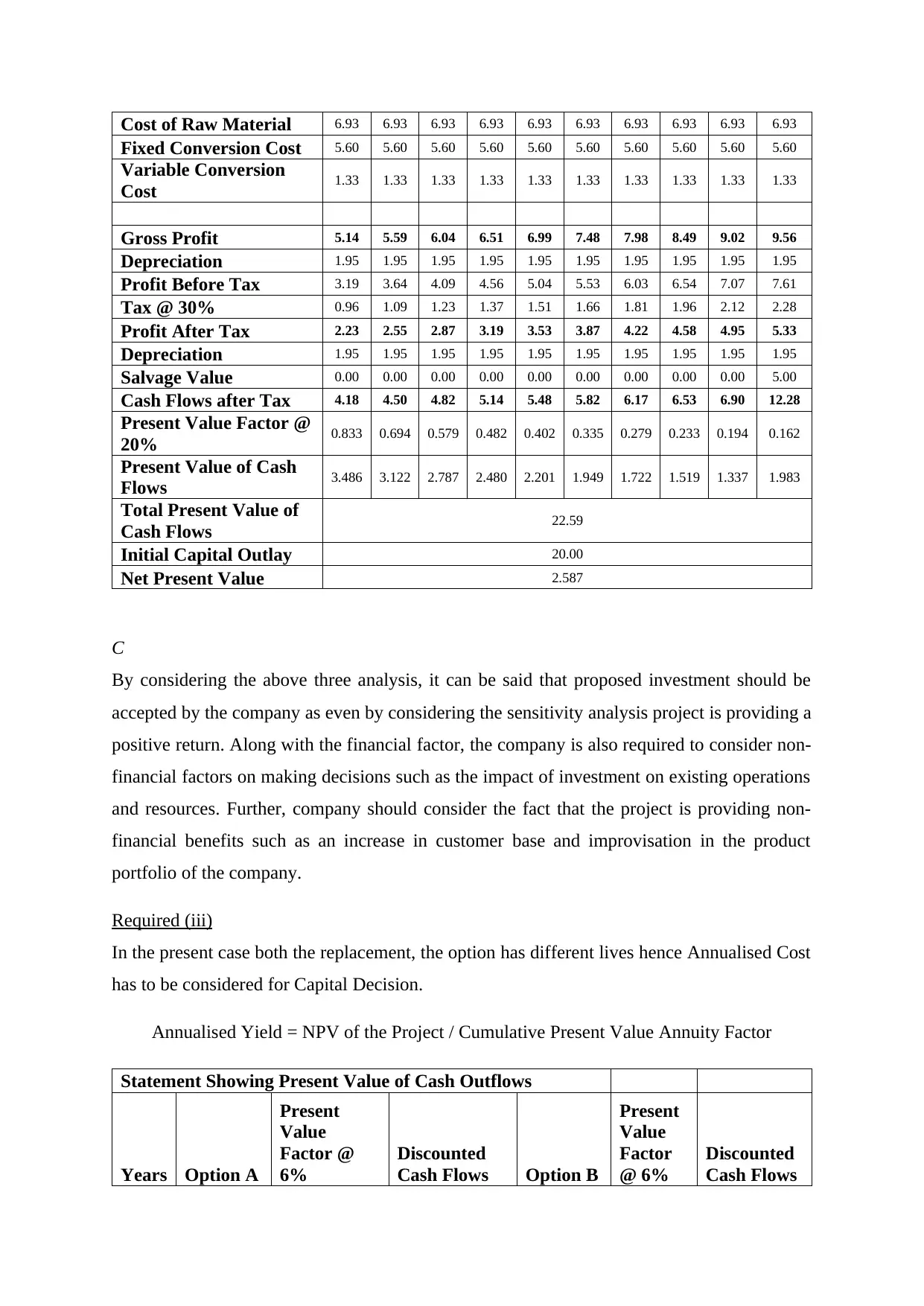
Cost of Raw Material 6.93 6.93 6.93 6.93 6.93 6.93 6.93 6.93 6.93 6.93
Fixed Conversion Cost 5.60 5.60 5.60 5.60 5.60 5.60 5.60 5.60 5.60 5.60
Variable Conversion
Cost 1.33 1.33 1.33 1.33 1.33 1.33 1.33 1.33 1.33 1.33
Gross Profit 5.14 5.59 6.04 6.51 6.99 7.48 7.98 8.49 9.02 9.56
Depreciation 1.95 1.95 1.95 1.95 1.95 1.95 1.95 1.95 1.95 1.95
Profit Before Tax 3.19 3.64 4.09 4.56 5.04 5.53 6.03 6.54 7.07 7.61
Tax @ 30% 0.96 1.09 1.23 1.37 1.51 1.66 1.81 1.96 2.12 2.28
Profit After Tax 2.23 2.55 2.87 3.19 3.53 3.87 4.22 4.58 4.95 5.33
Depreciation 1.95 1.95 1.95 1.95 1.95 1.95 1.95 1.95 1.95 1.95
Salvage Value 0.00 0.00 0.00 0.00 0.00 0.00 0.00 0.00 0.00 5.00
Cash Flows after Tax 4.18 4.50 4.82 5.14 5.48 5.82 6.17 6.53 6.90 12.28
Present Value Factor @
20% 0.833 0.694 0.579 0.482 0.402 0.335 0.279 0.233 0.194 0.162
Present Value of Cash
Flows 3.486 3.122 2.787 2.480 2.201 1.949 1.722 1.519 1.337 1.983
Total Present Value of
Cash Flows 22.59
Initial Capital Outlay 20.00
Net Present Value 2.587
C
By considering the above three analysis, it can be said that proposed investment should be
accepted by the company as even by considering the sensitivity analysis project is providing a
positive return. Along with the financial factor, the company is also required to consider non-
financial factors on making decisions such as the impact of investment on existing operations
and resources. Further, company should consider the fact that the project is providing non-
financial benefits such as an increase in customer base and improvisation in the product
portfolio of the company.
Required (iii)
In the present case both the replacement, the option has different lives hence Annualised Cost
has to be considered for Capital Decision.
Annualised Yield = NPV of the Project / Cumulative Present Value Annuity Factor
Statement Showing Present Value of Cash Outflows
Years Option A
Present
Value
Factor @
6%
Discounted
Cash Flows Option B
Present
Value
Factor
@ 6%
Discounted
Cash Flows
Fixed Conversion Cost 5.60 5.60 5.60 5.60 5.60 5.60 5.60 5.60 5.60 5.60
Variable Conversion
Cost 1.33 1.33 1.33 1.33 1.33 1.33 1.33 1.33 1.33 1.33
Gross Profit 5.14 5.59 6.04 6.51 6.99 7.48 7.98 8.49 9.02 9.56
Depreciation 1.95 1.95 1.95 1.95 1.95 1.95 1.95 1.95 1.95 1.95
Profit Before Tax 3.19 3.64 4.09 4.56 5.04 5.53 6.03 6.54 7.07 7.61
Tax @ 30% 0.96 1.09 1.23 1.37 1.51 1.66 1.81 1.96 2.12 2.28
Profit After Tax 2.23 2.55 2.87 3.19 3.53 3.87 4.22 4.58 4.95 5.33
Depreciation 1.95 1.95 1.95 1.95 1.95 1.95 1.95 1.95 1.95 1.95
Salvage Value 0.00 0.00 0.00 0.00 0.00 0.00 0.00 0.00 0.00 5.00
Cash Flows after Tax 4.18 4.50 4.82 5.14 5.48 5.82 6.17 6.53 6.90 12.28
Present Value Factor @
20% 0.833 0.694 0.579 0.482 0.402 0.335 0.279 0.233 0.194 0.162
Present Value of Cash
Flows 3.486 3.122 2.787 2.480 2.201 1.949 1.722 1.519 1.337 1.983
Total Present Value of
Cash Flows 22.59
Initial Capital Outlay 20.00
Net Present Value 2.587
C
By considering the above three analysis, it can be said that proposed investment should be
accepted by the company as even by considering the sensitivity analysis project is providing a
positive return. Along with the financial factor, the company is also required to consider non-
financial factors on making decisions such as the impact of investment on existing operations
and resources. Further, company should consider the fact that the project is providing non-
financial benefits such as an increase in customer base and improvisation in the product
portfolio of the company.
Required (iii)
In the present case both the replacement, the option has different lives hence Annualised Cost
has to be considered for Capital Decision.
Annualised Yield = NPV of the Project / Cumulative Present Value Annuity Factor
Statement Showing Present Value of Cash Outflows
Years Option A
Present
Value
Factor @
6%
Discounted
Cash Flows Option B
Present
Value
Factor
@ 6%
Discounted
Cash Flows
⊘ This is a preview!⊘
Do you want full access?
Subscribe today to unlock all pages.

Trusted by 1+ million students worldwide
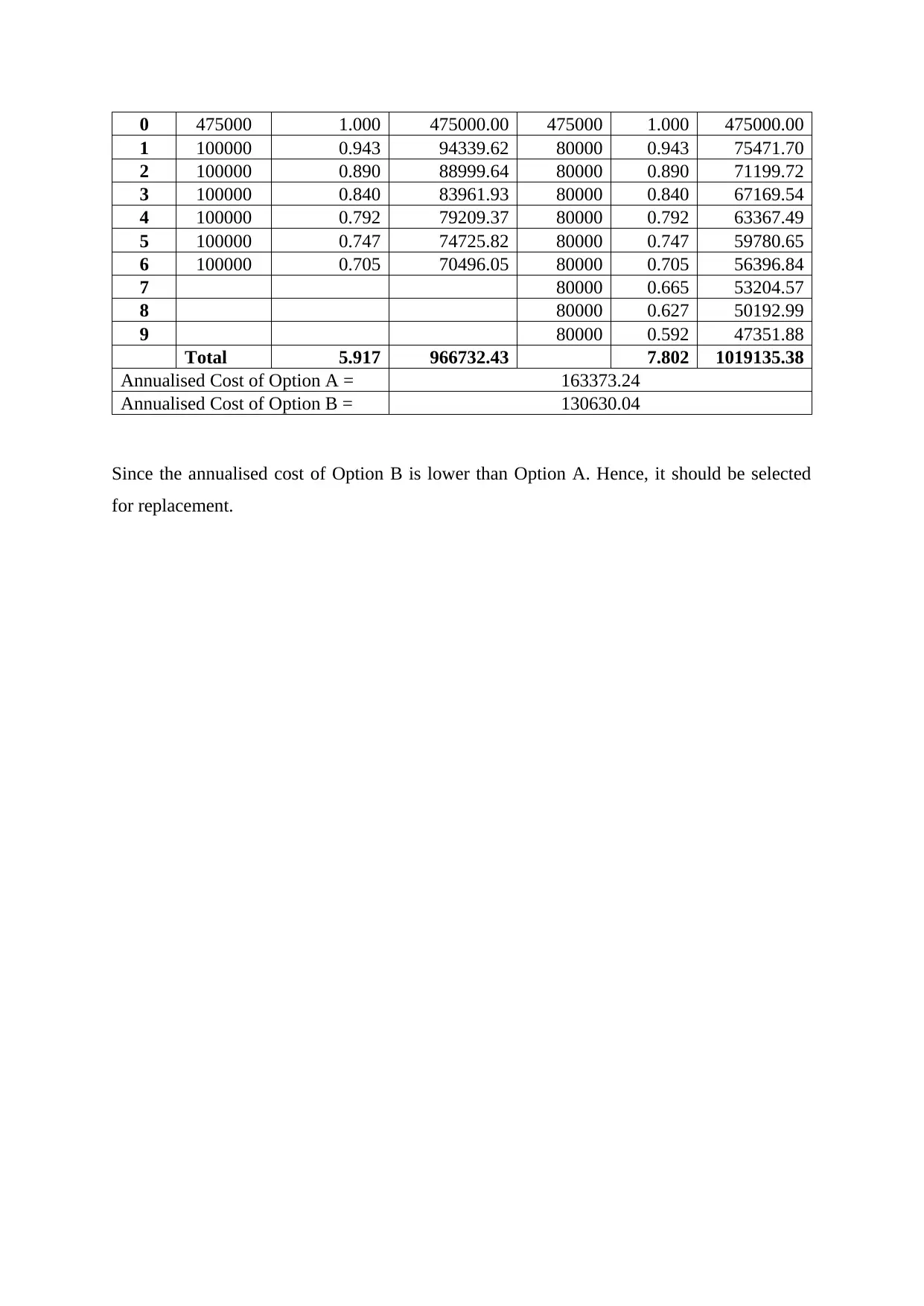
0 475000 1.000 475000.00 475000 1.000 475000.00
1 100000 0.943 94339.62 80000 0.943 75471.70
2 100000 0.890 88999.64 80000 0.890 71199.72
3 100000 0.840 83961.93 80000 0.840 67169.54
4 100000 0.792 79209.37 80000 0.792 63367.49
5 100000 0.747 74725.82 80000 0.747 59780.65
6 100000 0.705 70496.05 80000 0.705 56396.84
7 80000 0.665 53204.57
8 80000 0.627 50192.99
9 80000 0.592 47351.88
Total 5.917 966732.43 7.802 1019135.38
Annualised Cost of Option A = 163373.24
Annualised Cost of Option B = 130630.04
Since the annualised cost of Option B is lower than Option A. Hence, it should be selected
for replacement.
1 100000 0.943 94339.62 80000 0.943 75471.70
2 100000 0.890 88999.64 80000 0.890 71199.72
3 100000 0.840 83961.93 80000 0.840 67169.54
4 100000 0.792 79209.37 80000 0.792 63367.49
5 100000 0.747 74725.82 80000 0.747 59780.65
6 100000 0.705 70496.05 80000 0.705 56396.84
7 80000 0.665 53204.57
8 80000 0.627 50192.99
9 80000 0.592 47351.88
Total 5.917 966732.43 7.802 1019135.38
Annualised Cost of Option A = 163373.24
Annualised Cost of Option B = 130630.04
Since the annualised cost of Option B is lower than Option A. Hence, it should be selected
for replacement.
Paraphrase This Document
Need a fresh take? Get an instant paraphrase of this document with our AI Paraphraser
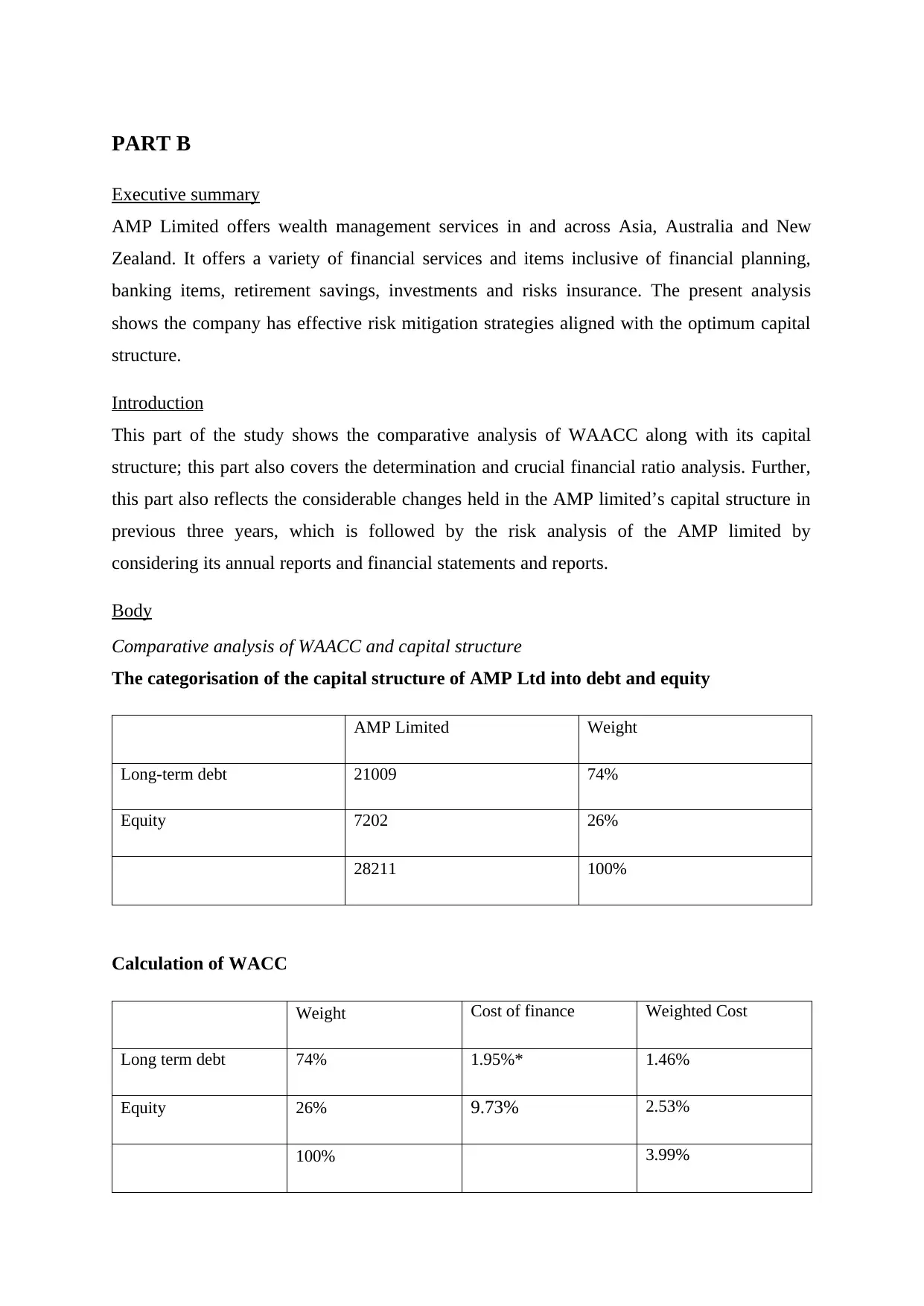
PART B
Executive summary
AMP Limited offers wealth management services in and across Asia, Australia and New
Zealand. It offers a variety of financial services and items inclusive of financial planning,
banking items, retirement savings, investments and risks insurance. The present analysis
shows the company has effective risk mitigation strategies aligned with the optimum capital
structure.
Introduction
This part of the study shows the comparative analysis of WAACC along with its capital
structure; this part also covers the determination and crucial financial ratio analysis. Further,
this part also reflects the considerable changes held in the AMP limited’s capital structure in
previous three years, which is followed by the risk analysis of the AMP limited by
considering its annual reports and financial statements and reports.
Body
Comparative analysis of WAACC and capital structure
The categorisation of the capital structure of AMP Ltd into debt and equity
AMP Limited Weight
Long-term debt 21009 74%
Equity 7202 26%
28211 100%
Calculation of WACC
Weight Cost of finance Weighted Cost
Long term debt 74% 1.95%* 1.46%
Equity 26% 9.73% 2.53%
100% 3.99%
Executive summary
AMP Limited offers wealth management services in and across Asia, Australia and New
Zealand. It offers a variety of financial services and items inclusive of financial planning,
banking items, retirement savings, investments and risks insurance. The present analysis
shows the company has effective risk mitigation strategies aligned with the optimum capital
structure.
Introduction
This part of the study shows the comparative analysis of WAACC along with its capital
structure; this part also covers the determination and crucial financial ratio analysis. Further,
this part also reflects the considerable changes held in the AMP limited’s capital structure in
previous three years, which is followed by the risk analysis of the AMP limited by
considering its annual reports and financial statements and reports.
Body
Comparative analysis of WAACC and capital structure
The categorisation of the capital structure of AMP Ltd into debt and equity
AMP Limited Weight
Long-term debt 21009 74%
Equity 7202 26%
28211 100%
Calculation of WACC
Weight Cost of finance Weighted Cost
Long term debt 74% 1.95%* 1.46%
Equity 26% 9.73% 2.53%
100% 3.99%
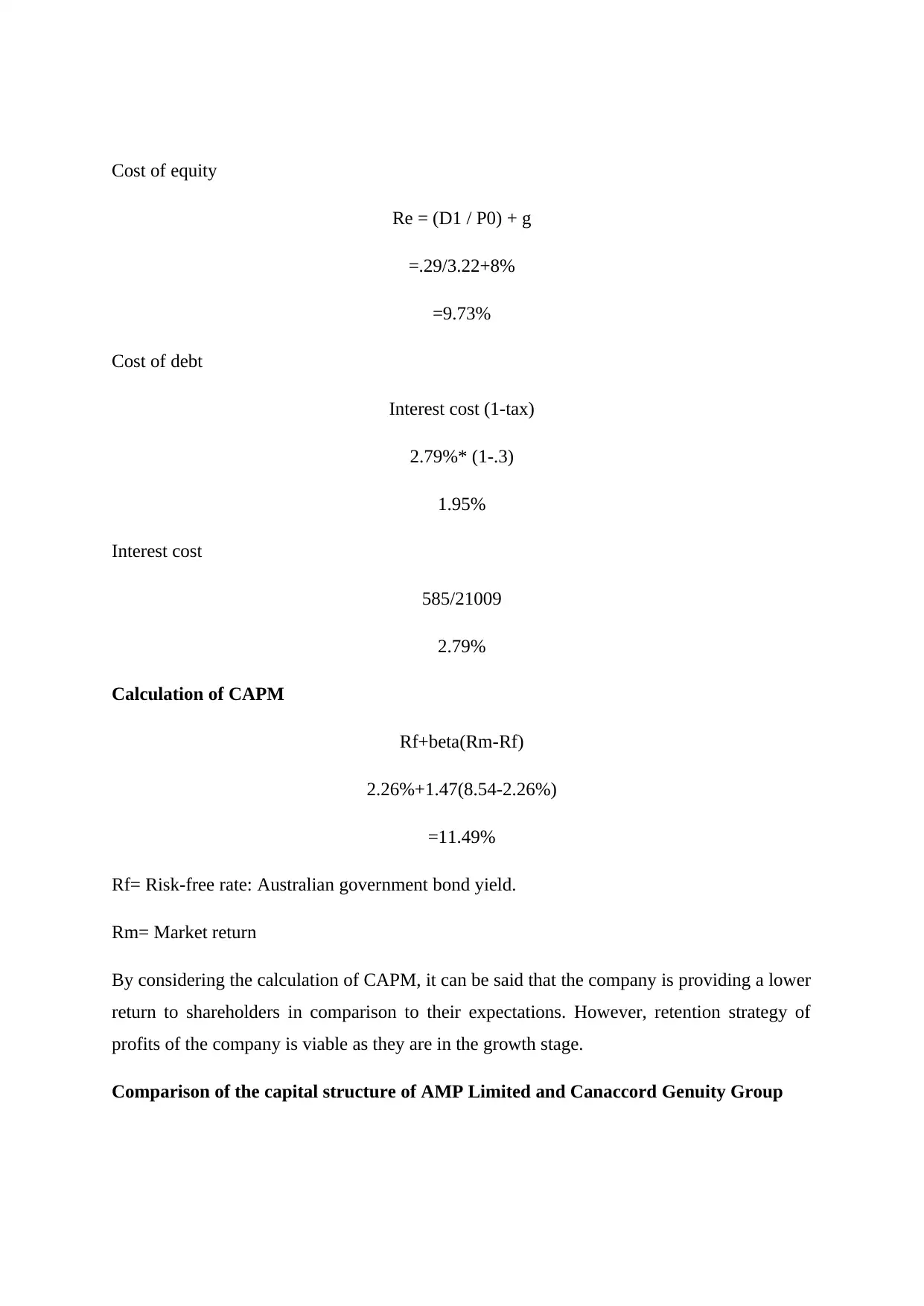
Cost of equity
Re = (D1 / P0) + g
=.29/3.22+8%
=9.73%
Cost of debt
Interest cost (1-tax)
2.79%* (1-.3)
1.95%
Interest cost
585/21009
2.79%
Calculation of CAPM
Rf+beta(Rm-Rf)
2.26%+1.47(8.54-2.26%)
=11.49%
Rf= Risk-free rate: Australian government bond yield.
Rm= Market return
By considering the calculation of CAPM, it can be said that the company is providing a lower
return to shareholders in comparison to their expectations. However, retention strategy of
profits of the company is viable as they are in the growth stage.
Comparison of the capital structure of AMP Limited and Canaccord Genuity Group
Re = (D1 / P0) + g
=.29/3.22+8%
=9.73%
Cost of debt
Interest cost (1-tax)
2.79%* (1-.3)
1.95%
Interest cost
585/21009
2.79%
Calculation of CAPM
Rf+beta(Rm-Rf)
2.26%+1.47(8.54-2.26%)
=11.49%
Rf= Risk-free rate: Australian government bond yield.
Rm= Market return
By considering the calculation of CAPM, it can be said that the company is providing a lower
return to shareholders in comparison to their expectations. However, retention strategy of
profits of the company is viable as they are in the growth stage.
Comparison of the capital structure of AMP Limited and Canaccord Genuity Group
⊘ This is a preview!⊘
Do you want full access?
Subscribe today to unlock all pages.

Trusted by 1+ million students worldwide
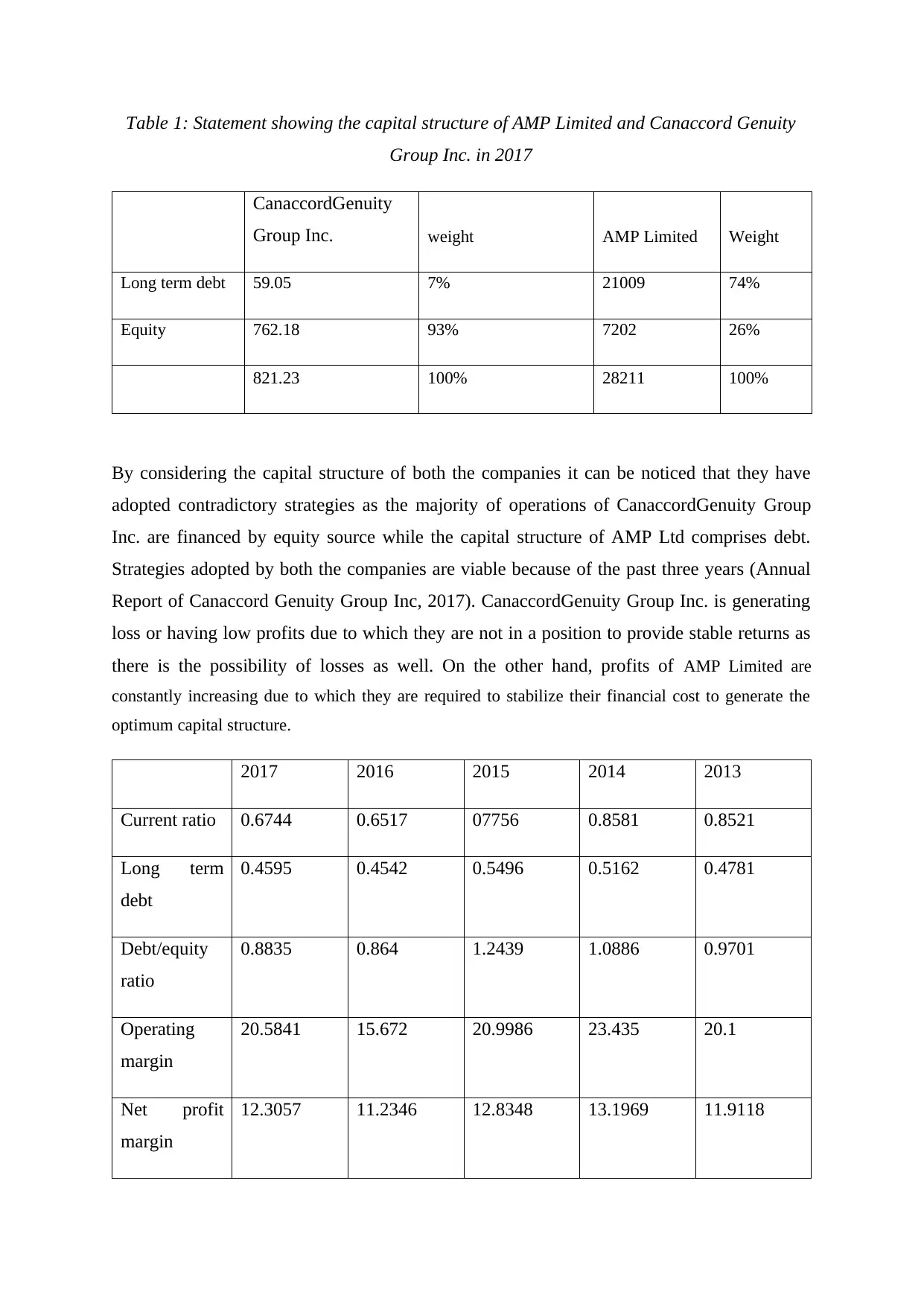
Table 1: Statement showing the capital structure of AMP Limited and Canaccord Genuity
Group Inc. in 2017
CanaccordGenuity
Group Inc. weight AMP Limited Weight
Long term debt 59.05 7% 21009 74%
Equity 762.18 93% 7202 26%
821.23 100% 28211 100%
By considering the capital structure of both the companies it can be noticed that they have
adopted contradictory strategies as the majority of operations of CanaccordGenuity Group
Inc. are financed by equity source while the capital structure of AMP Ltd comprises debt.
Strategies adopted by both the companies are viable because of the past three years (Annual
Report of Canaccord Genuity Group Inc, 2017). CanaccordGenuity Group Inc. is generating
loss or having low profits due to which they are not in a position to provide stable returns as
there is the possibility of losses as well. On the other hand, profits of AMP Limited are
constantly increasing due to which they are required to stabilize their financial cost to generate the
optimum capital structure.
2017 2016 2015 2014 2013
Current ratio 0.6744 0.6517 07756 0.8581 0.8521
Long term
debt
0.4595 0.4542 0.5496 0.5162 0.4781
Debt/equity
ratio
0.8835 0.864 1.2439 1.0886 0.9701
Operating
margin
20.5841 15.672 20.9986 23.435 20.1
Net profit
margin
12.3057 11.2346 12.8348 13.1969 11.9118
Group Inc. in 2017
CanaccordGenuity
Group Inc. weight AMP Limited Weight
Long term debt 59.05 7% 21009 74%
Equity 762.18 93% 7202 26%
821.23 100% 28211 100%
By considering the capital structure of both the companies it can be noticed that they have
adopted contradictory strategies as the majority of operations of CanaccordGenuity Group
Inc. are financed by equity source while the capital structure of AMP Ltd comprises debt.
Strategies adopted by both the companies are viable because of the past three years (Annual
Report of Canaccord Genuity Group Inc, 2017). CanaccordGenuity Group Inc. is generating
loss or having low profits due to which they are not in a position to provide stable returns as
there is the possibility of losses as well. On the other hand, profits of AMP Limited are
constantly increasing due to which they are required to stabilize their financial cost to generate the
optimum capital structure.
2017 2016 2015 2014 2013
Current ratio 0.6744 0.6517 07756 0.8581 0.8521
Long term
debt
0.4595 0.4542 0.5496 0.5162 0.4781
Debt/equity
ratio
0.8835 0.864 1.2439 1.0886 0.9701
Operating
margin
20.5841 15.672 20.9986 23.435 20.1
Net profit
margin
12.3057 11.2346 12.8348 13.1969 11.9118
Paraphrase This Document
Need a fresh take? Get an instant paraphrase of this document with our AI Paraphraser
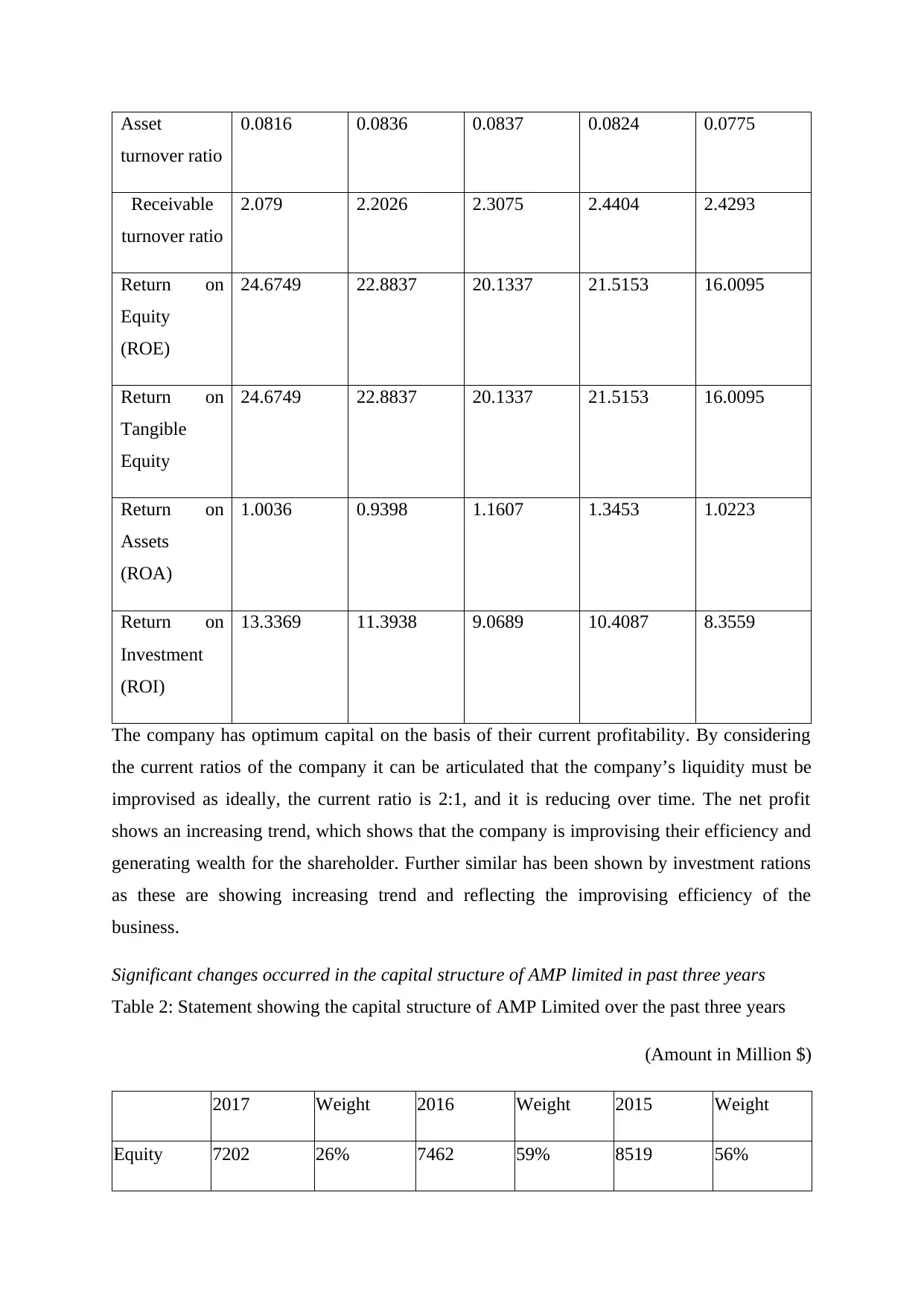
Asset
turnover ratio
0.0816 0.0836 0.0837 0.0824 0.0775
Receivable
turnover ratio
2.079 2.2026 2.3075 2.4404 2.4293
Return on
Equity
(ROE)
24.6749 22.8837 20.1337 21.5153 16.0095
Return on
Tangible
Equity
24.6749 22.8837 20.1337 21.5153 16.0095
Return on
Assets
(ROA)
1.0036 0.9398 1.1607 1.3453 1.0223
Return on
Investment
(ROI)
13.3369 11.3938 9.0689 10.4087 8.3559
The company has optimum capital on the basis of their current profitability. By considering
the current ratios of the company it can be articulated that the company’s liquidity must be
improvised as ideally, the current ratio is 2:1, and it is reducing over time. The net profit
shows an increasing trend, which shows that the company is improvising their efficiency and
generating wealth for the shareholder. Further similar has been shown by investment rations
as these are showing increasing trend and reflecting the improvising efficiency of the
business.
Significant changes occurred in the capital structure of AMP limited in past three years
Table 2: Statement showing the capital structure of AMP Limited over the past three years
(Amount in Million $)
2017 Weight 2016 Weight 2015 Weight
Equity 7202 26% 7462 59% 8519 56%
turnover ratio
0.0816 0.0836 0.0837 0.0824 0.0775
Receivable
turnover ratio
2.079 2.2026 2.3075 2.4404 2.4293
Return on
Equity
(ROE)
24.6749 22.8837 20.1337 21.5153 16.0095
Return on
Tangible
Equity
24.6749 22.8837 20.1337 21.5153 16.0095
Return on
Assets
(ROA)
1.0036 0.9398 1.1607 1.3453 1.0223
Return on
Investment
(ROI)
13.3369 11.3938 9.0689 10.4087 8.3559
The company has optimum capital on the basis of their current profitability. By considering
the current ratios of the company it can be articulated that the company’s liquidity must be
improvised as ideally, the current ratio is 2:1, and it is reducing over time. The net profit
shows an increasing trend, which shows that the company is improvising their efficiency and
generating wealth for the shareholder. Further similar has been shown by investment rations
as these are showing increasing trend and reflecting the improvising efficiency of the
business.
Significant changes occurred in the capital structure of AMP limited in past three years
Table 2: Statement showing the capital structure of AMP Limited over the past three years
(Amount in Million $)
2017 Weight 2016 Weight 2015 Weight
Equity 7202 26% 7462 59% 8519 56%

Debt 21009 74% 5241 41% 6664 44%
28211 100% 12703 100% 15183 100%
The above table shows that, company in the past years was giving weight to equity and
investing in the same to stabilize their profits, but however now they have given
consideration to debt, and by the main reason for investing in debt is that they are in pursuit
to maintain their capital structure and from effective profit stabilization, and by raising more
debt they will be able to generate more of revenues and are not obligatory to provide more
returns to shareholders, as their returns will be fixed, whereby the company can enjoy more
profits and maintain an optimum financial structure(Annual Report of AMP Limited, 2016).
Overall, the decision of the raising debt by the company is good, because the performance
and profitability of the company are showing increasing trend, which in turns help in
stabilizing the profits and fix the return of shareholders, so that company can grow and drive
competitiveness and profitability thereof.
Risk analysis of AMP Limited
By considering the above table, it can be said that return on investments, equity and assets are
improvising on a yearly basis, which is showing that company is performing well in the
market and implementing strategies line to line with the material risks to ensure optimal
operational management and smooth financial performance (MacroTrends, 2018). This
approach shows that identified risks were supported by their core operations and it is
mitigated in an appropriate manner which can be noticed by improvising health of
shareholders, as the investment ratios are showing increasing trend.
The AMP’s managerial authorities are liable for determining, considering, monitoring and
mitigating the business managerial risks. The unit teams of business have delegated the duty
to make decisions and execute the daily business while mitigating risks and the ultimate
profits and loss in light of the risk appetite of the board and effective risk management
strategies. The AMP has managed the risks by designing, adopting and managing the
practices and procedures to determine, consider and monitor risks and offer advice with
assessing the material business decisions properly (Annual Report of AMP Limited, 2017).
The team of AMP also offers strategic advice and solutions to the decisions based on the first
line while offering assurance to the board that the risk profile is lined with the expectations of
the board. Further, the AMP has classified risks into seven types of material risks which are
28211 100% 12703 100% 15183 100%
The above table shows that, company in the past years was giving weight to equity and
investing in the same to stabilize their profits, but however now they have given
consideration to debt, and by the main reason for investing in debt is that they are in pursuit
to maintain their capital structure and from effective profit stabilization, and by raising more
debt they will be able to generate more of revenues and are not obligatory to provide more
returns to shareholders, as their returns will be fixed, whereby the company can enjoy more
profits and maintain an optimum financial structure(Annual Report of AMP Limited, 2016).
Overall, the decision of the raising debt by the company is good, because the performance
and profitability of the company are showing increasing trend, which in turns help in
stabilizing the profits and fix the return of shareholders, so that company can grow and drive
competitiveness and profitability thereof.
Risk analysis of AMP Limited
By considering the above table, it can be said that return on investments, equity and assets are
improvising on a yearly basis, which is showing that company is performing well in the
market and implementing strategies line to line with the material risks to ensure optimal
operational management and smooth financial performance (MacroTrends, 2018). This
approach shows that identified risks were supported by their core operations and it is
mitigated in an appropriate manner which can be noticed by improvising health of
shareholders, as the investment ratios are showing increasing trend.
The AMP’s managerial authorities are liable for determining, considering, monitoring and
mitigating the business managerial risks. The unit teams of business have delegated the duty
to make decisions and execute the daily business while mitigating risks and the ultimate
profits and loss in light of the risk appetite of the board and effective risk management
strategies. The AMP has managed the risks by designing, adopting and managing the
practices and procedures to determine, consider and monitor risks and offer advice with
assessing the material business decisions properly (Annual Report of AMP Limited, 2017).
The team of AMP also offers strategic advice and solutions to the decisions based on the first
line while offering assurance to the board that the risk profile is lined with the expectations of
the board. Further, the AMP has classified risks into seven types of material risks which are
⊘ This is a preview!⊘
Do you want full access?
Subscribe today to unlock all pages.

Trusted by 1+ million students worldwide
1 out of 15
Your All-in-One AI-Powered Toolkit for Academic Success.
+13062052269
info@desklib.com
Available 24*7 on WhatsApp / Email
![[object Object]](/_next/static/media/star-bottom.7253800d.svg)
Unlock your academic potential
Copyright © 2020–2026 A2Z Services. All Rights Reserved. Developed and managed by ZUCOL.

